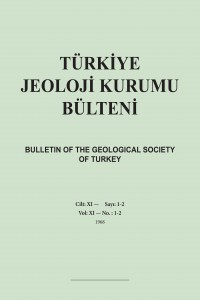Research Article
Year 1968,
Volume: 11 Issue: 1-2, 117 - 131, 30.10.1968
Abstract
Burada anlatılan çalışmalar 1966-1967 senelerinde İngiltere Durham Üniversitesinde iştirak edilen «Mühendislik Jeolojisi» M. Sc. çalışmalarının bir kısmını kapsamaktadır.
Laboratuvar deneyleriyle takribi kantitatif değerler elde ederek, bu verileri, özellikle ağır mühendislik yapılarında, taşıma gücü problemlerinin çözümünde kullanmak genellikle başvurulan bir usuldür. Böyle durumlarda tek eksenli kompresyon deneyleri (unconfined compression tests) yaparak, deneysel kurallar ve formüllerle yüklenmesi caiz ağırlıklar hesap edilebilir.
Tek eksenli kompresyon deney neticeleri, temellerin homojenliği ve izotropisini tahkik etmek için kıymetli verilerdir. Küçük numuneler üzerinde çok sayıda deney yapılabilir ve bu suretle nem muhtevası ve ayrışma gibi çeşitli değişkenlerin (parameter) temelin mekanik özellikleri üzerindeki etkileri öğrenilebilir. Ayrıca, yerinde (in situ) yapılan deney neticeleri ile karşılaştırmalar temel hendeği boyunca korelâsyonların yapılmasını da mümkün kılar.
Tek eksenli kompresyon mukavemeti ilk ağızda kayaç dokusunun (rock fabric) sağlamlığı hakkında fikir verir. Aynı zamanda, kompresyon mukavemeti ile kayacın elastisite modülü ve gevrekliği arasında kabaca bir korelâsyonun bulunduğu da bilinmektedir (Coates, 1964). Kayaçların bu özelliği kolaylıkla ve süratli bir şekilde ölçülebilir ve gerilme-deformasyon davranışlarının (stress-strain behavior) bir fonksiyonu olan elastisite modülü hesaplanabilir.
Şüphesiz ki, tabiattaki kaya bloku hapsedilmiş (confined) bir durumdadır ve bu blokun kompresyon mukavemetinin, aynı bloktan alınmış ve laboratuvarda tek eksenli (unconfined) kompresyon deneyine tabi tutulmuş numunesinden daha büyük olması beklenir. Fakat bu tip deney neticeleri vasıtasıyle kıymetlendirilecek olan temel şartları emin tarafta olacaktır. Bununla beraber, yan basınçların neticesi olan bu mukavemet artışının, büyük kaya kitlesi içindeki zayıflık düzlemleri sebebiyle geniş ölçüde bertaraf edilebileceği daima göz önünde bulundurulmalıdır.
Bu çalışmalarda Vestfalien yaşlı Coal Measures formasyonunda açılmış bir kuyunun karotlarından uygun olanları seçilip, kompresyon veya kırılma mukavemetlerinin (crushing strength) tayini için deneye tabi tutulmuşlardır.
Bundan başka, numunelerin alınmış olduğu yerlere yakın bazı müsait zonlarda Schmidt tepki çekici (Schmidt rebound hammer) kullanılarak, kompresyon mukavemeti ile çekicin geri tepme yüksekliği arasında bir ilginin olup olmadığı araştırılmıştır.
Deney neticelerinin daha sıhhatle kıymetlendirilebilmesi bakımından numunelerin nem muhtevası, karbon muhtevası, özgül ağırlık, birim hacim ağırlık ve porozite tayinleri de yapılmıştır.
References
- BRACE, W. F. (1961): Dependence of fracture strength of rocks on grain size. Penn. State Univ. Mineral Ind. Expt. Sta. Bull., 76, pp. 99-103.
- BRACE, W. F. (1963): Brittle fracture of rocks. Int. Conf. on State of Stress in the Earth's Crust, Elsevier, pp. 111-180.
- COATES, D. F. (1964): Classification of rocks for rock mechanics. Int. J. Rock Mech. Min. Sci., vol. 1, pp. 421-429.
- COATES, D. F. & PARSONS, R. C. (1966): Experimental criteria for classification of rock substances. Int. J. Rock Mech. Min. Sci., vol. 3, pp. 181-189.
- DUNCAN, No (1967): Rock mechanics and earthworks engineering. Muck Shifter, Ocak, pp. 35-40.
- GRAMBERG, J. (1965): Axial cleavage fracturing, a significant process in mining and geology. Engineering Geology, vol. 1, pp. 31-72.
- GRIFFITH, A. A. (1921): The phenomena of flow and rupture and flow in solids. Phil. Trans. Roy. Soc. London, voL 221, pp. 163.
- HAWKES, I. (1966): Moduli measurements on rock cores. Proc. First Congr. Int. Soc. Rock Mech., vol. 1, pp. 655-660.
- HOBBS, D. W. (1964): Rock compressive strength. Colliery Engineering, vol. 41 pp. 287-292.
- HUCKA, V. (1965): A rapid method of determining the strength of rock in situ. Int. J. Rock Mech. Min. Sci. vol. 2, pp. 127-134.
- JAEGER, J. C. (1964): Elasticity, fracture and Flow. Methuen and Co. Ltd. London.
- KNILL, J. L. & JONES, K. S. (1965): The recording and interpretation of geological conditions in the foundations of the Roseires, Kariha, and Latiyan dams. Géotechnique, vol. 15, pp. 94-124.
- McCLINTOCK, F. A. & WALSH, J. (1962): Friction of Griffith cracks in rocks under pressure. Proc. Fourth U.S. Natl. Congr. Appl. Mech., Berkeley.
- OBERT, L.; WINDES, S. L. & DUVALL, W. I. (1946) : Standardized tests for determining the physical properties of mine rock. U.S. Bureau of Mines, Report, 3891.
- PRICE, N. J. (1958): A study of rock properties in conditions of triaxial stress. Mechanical Properties of Non-Metallic Brittle Materials, Butterworths. London, pp. 106-122.
- PRICE, N. J. (1963): The influence of geological factors on the strength of coal measure rocks. Geological Magazine, vol. 100, pp. 428-443.
- SELDENRATH, Th. R. & GRAMBERG, J. (1958) : Stress-strain relations and breakage of rocks. Mechanical Properties of Non-Metallic Brittle Materials, Butterworths, London, pp. 79-105.
- TIMOSHENKO, S. P. (1953): History of strength of materials. McGraw-Hill, New York.
- WRIGHT, P. J. F. (1955): Comments on an indirect tensile test on concrete cylinders. Mag. Concrete Res., vol. 20, pp. 87-96.
There are 19 citations in total.
Details
| Primary Language | Turkish |
|---|---|
| Subjects | General Geology, Geological Sciences and Engineering (Other) |
| Journal Section | Research Article |
| Authors | |
| Publication Date | October 30, 1968 |
| Submission Date | January 1, 1968 |
| Acceptance Date | June 1, 1968 |
| Published in Issue | Year 1968 Volume: 11 Issue: 1-2 |
Cite
Instructions for Authors: http://www.jmo.org.tr/yayinlar/tjb_yazim_kurallari.php
Ethical Statement and Copyrighy Form: https://www.jmo.org.tr/yayinlar/tjb_telif_etik_formlar.php

